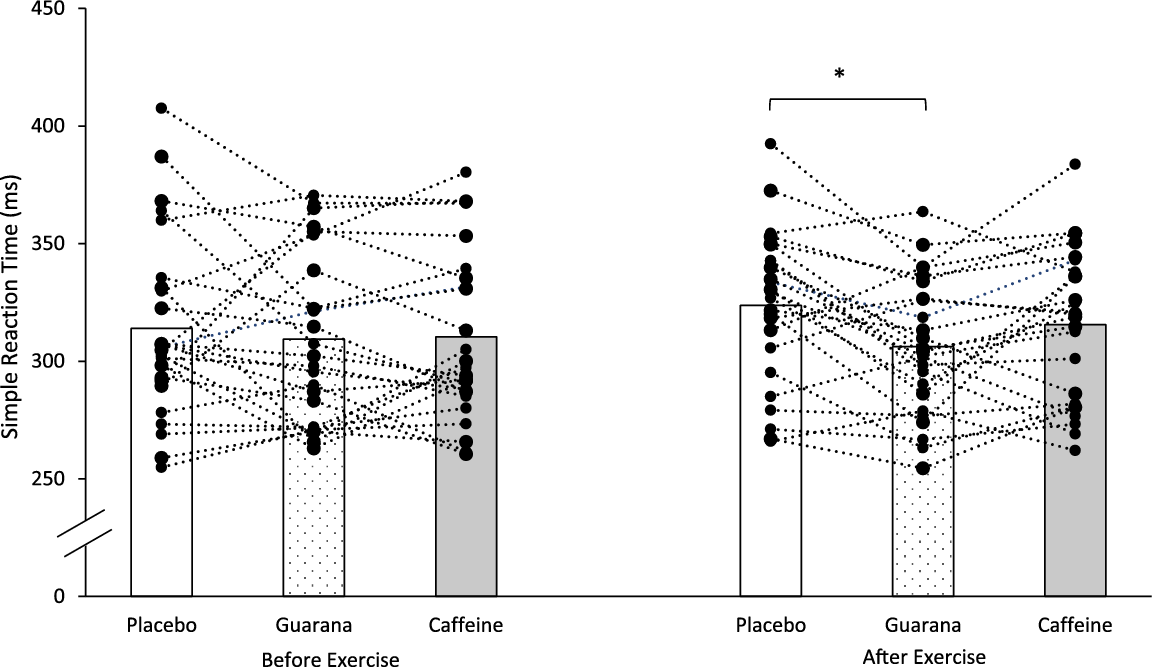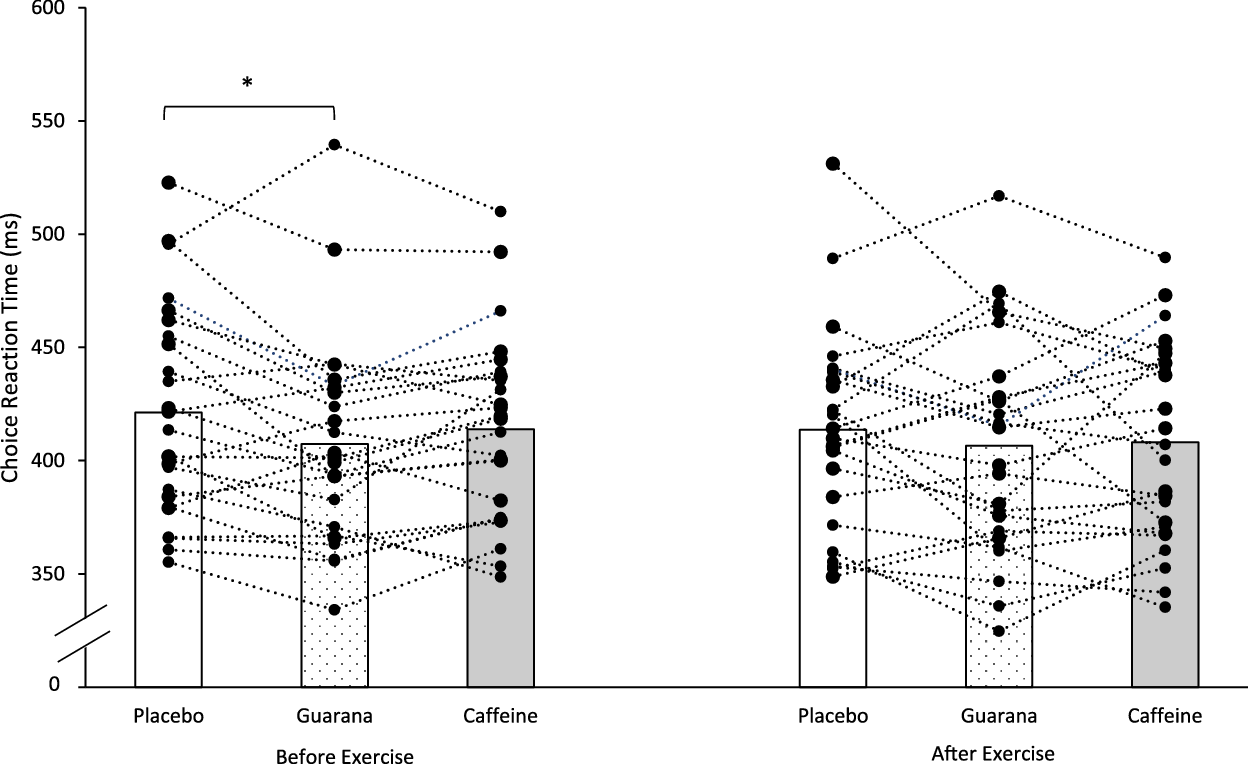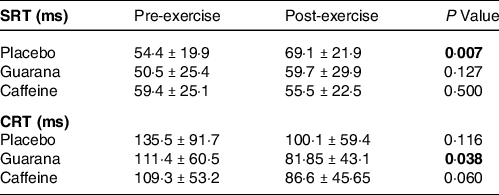Guarana (Paullinia cupana) is a native fruit of the Amazonian basin which has been used as a traditional medicine for centuries by indigenous populations(Reference Schimpl, da Silva and de Carvalho Gonçalves1). The purported biological effects of supplementation are extensive. Reports demonstrate guarana to possess psychoactive and diuretic properties, as well as exhibiting antioxidant and anti-fungal effects(Reference Marques, Ferreira and de Paula2). Positive stimulating and cognitive effects of guarana have also been reported, with the high caffeine content of its seed (up to 6 % dry weight) being the predominant suggested mechanism of action(Reference Schimpl, da Silva and de Carvalho Gonçalves1). Indeed, caffeine supplementation possesses a strong efficacy for improvements in a variety of cognitive(Reference McLellan, Caldwell and Lieberman3) and physical performances(Reference Maughan, Burke and Dvorak4). The ubiquitous psychostimulant is predominantly metabolised in the liver by the cytochrome P450 enzyme system(Reference Grzegorzewski, Bartsch and Köller5). Cytochrome P450 isoform 1A2 (CRP1A2) mediates the main caffeine demethylation reaction of N-3 demethylation to paraxanthine, which equates up to 90 % of caffeine demethylation(Reference Grzegorzewski, Bartsch and Köller5,Reference Pomportes, Brisswalter and Casini6) . The antagonism of adenosine receptors also modulates the rapid movement across the blood–brain barrier which consequently augments dopamine concentrations in the brain(Reference Pomportes, Brisswalter and Casini6), resulting in heighted alertness, vigilance, attention and reaction time(Reference McLellan, Caldwell and Lieberman3). However, despite the possible ergogenic effects derived from the caffeine content in guarana, reports suggest that the caffeine content is small in typically consumed doses, and in some cases lower than the pharmacological threshold required for humans(Reference Haskell, Kennedy and Wesnes7). As such, some studies indicate that additional components may also be the contributing mechanism(Reference Schimpl, da Silva and de Carvalho Gonçalves1,Reference Haskell, Kennedy and Wesnes7,Reference Pomportes, Davranche and Brisswalter8) . Consequently, guarana has become increasingly popular in commercial markets worldwide, particularly in the soft drink and supplementation industry(Reference Schimpl, da Silva and de Carvalho Gonçalves1,Reference Marques, Ferreira and de Paula2) .
Initial studies conducted by Galduróz and colleagues(Reference Galduróz and Carlini9,Reference Galduróz and Carlini10) evaluated the acute (1 g/d for 3 d) and chronic (1 g/d for 150 d) cognitive effects of guarana supplementation in young and elderly individuals but found no changes to cognition, sleep or anxiety in either group. No further studies have assessed the long-term effects, but several studies have since reported significant acute cognitive changes following guarana supplementation(Reference Haskell, Kennedy and Wesnes7,Reference Kennedy, Haskell and Wesnes11–Reference Veasey, Haskell-Ramsay and Kennedy13) . Kennedy et al. (Reference Kennedy, Haskell and Wesnes11) found both speed of attention and secondary memory were improved by a 75 mg dose of guarana. The increase in speed of attention is reflected in a decrease of reaction time observed in several other studies(Reference Pomportes, Davranche and Brisswalter8,Reference Kennedy, Haskell and Wesnes11,Reference Scholey, Bauer and Neale14,Reference White, Camfield and Maggini15) . Haskell et al. (Reference Haskell, Kennedy and Wesnes7) corroborated that secondary memory was improved with both 75 and 37·5 mg of guarana. Notably, the lower dose contained less than 9 mg of caffeine, which is considered less than the threshold for pharmacological activity in humans(Reference Haskell, Kennedy and Wesnes7). It is therefore speculated that other pharmacokinetic components of guarana (tannins, saponins and flavonoids such as catechins and epicatechins; methylxanthines such as theobromine and theophylline) may be working synergistically with caffeine to enhance the psychoactive effects of the supplement(Reference Schimpl, da Silva and de Carvalho Gonçalves1,Reference Haskell, Kennedy and Wesnes7–Reference Galduróz and Carlini9,Reference Kennedy, Haskell and Wesnes11) . Comparing the effects of guarana to caffeine alone may therefore help elucidate the contribution of the other components within the supplement.
Successful performance in many modern sports necessitates an athlete’s capacity to simultaneously control a variety of physiological and cognitive loads. Such sports include modern pentathlon whereby optimal cognitive functioning is essential during combined events (laser-run)(Reference Pomportes, Brisswalter and Hays16) or team sports where many relevant external attentional cues demand quick and accurate decisions. Though it is recognised that moderate exercise improves cognitive performance, higher/maximal intensities are said to worsen cognitive performance(Reference Brisswalter, Collardeau and René17). Yet to the best of our knowledge, only four studies so far have considered how physical activity may alter the cognitive effects of guarana supplementation, all of which have used moderate intensity exercise (60 % V̇O2max/peak power and/or rating of perceived exertion (RPE) 13/20) for 30–40 min(Reference Pomportes, Brisswalter and Casini6,Reference Pomportes, Davranche and Brisswalter8,Reference Veasey, Haskell-Ramsay and Kennedy13,Reference Pomportes, Brisswalter and Hays16) . An interaction between physical activity and guarana supplementation was reported in only one of the studies, where mean reaction time decreased following guarana supplementation in pentathletes after running at an RPE of 13 on the Borg scale(Reference Pomportes, Brisswalter and Hays16). Moreover, only one study reported any significant changes to cognition following guarana supplementation alone, and both a decreased reaction time and stable autonomic nervous system (heart rate variability) were reported(Reference Pomportes, Davranche and Brisswalter8). It is therefore difficult to determine whether the absence of significant changes was the result of combining physical activity and guarana, or due to other extenuating factors.
It is apparent that guarana supplementation affects several areas of cognition which could be highly appealing to athletes who compete in sports that rely heavily on accurate and efficient decision-making processes for successful performance. However, thus far, evidence on how guarana supplementation affects cognitive performance during physical activity is equivocal and limited, particularly as all previous studies have only considered moderate intensities. Increasing the intensity of physical activity is likely to alter the associated fatigue and may therefore interact differently with supplementation compared with moderate intensities of exercise. Therefore, the aim of this study was to evaluate the effects of guarana supplementation on cognitive performance, before and after a bout of maximal intensity exercise. It was hypothesised that guarana supplementation would improve cognitive performance in comparison with caffeine and placebo following a bout of maximal intensity exercise.
Methods
Subjects
Twenty-seven physically active participants were recruited from the local university and cycling clubs and two dropped out due to injury or personal extenuating circumstances leaving twenty-five (age: 21 (sd 1) years, height: 172·4 (sd 15·3) cm, mass: 68·5 (sd 12·6) kg). The participants comprised eighteen males and seven females. Participants were considered physically active if they met the UK recommended physical activity guidelines (at least 30 min of moderate intensity activity five times per week). The mean daily caffeine intake of participants was 122 (sd 114) mg. All participants completed both informed consent and physical activity readiness questionnaire forms prior to participation. This study was approved by the UCL Research Ethics Committee in line with the Declaration of Helsinki.
Supplementation
Employing a double-blind randomised crossover design, participants attended the exercise laboratory on 3-separate days, each 1-week apart. Participants were asked not to eat in the 2-h before testing and not to consume caffeine or alcohol in the 24-h prior to testing. During the intervention, participants were also asked to maintain their regular diet and not to consume any supplements. On each visit, participants drank a different supplement in a randomised order: caffeine (5 mg/kg) (Caffeine, Loughborough, Fisher Scientific), guarana (125 mg/kg) (Guarana Powder, Brighton, The Guarana Company Ltd.) or placebo (65 mg/kg) (protein powder containing undenatured whey protein isolate and instantising agent). The caffeine dose in both caffeine and guarana supplement is in line with the suggested protocol of use by the International Olympic Committee(Reference Maughan, Burke and Dvorak4). Supplements were diluted in 250 ml of room temperature water and placed into opaque water bottles by an independent member of staff. To minimise olfactory and taste input, participants were instructed to hold their nose while drinking. To enhance the blinding and reduce bias further, participants were initially informed of the broad scope of the study (‘investigating the influences of different supplements on exercise and cognitive function’) but were not informed about the specific supplements and their purported effects. HPLC was performed to determine the caffeine content of the guarana supplement. This was found to be 3·99 %. The guarana dose was then calculated to match the caffeine content of the caffeine supplement given. After drinking the supplement, participants relaxed quietly for 30 min. Following this, participants completed the first set of cognitive tests (see below for protocol).
A V̇O2max test was then completed on a cycle ergometer (CareFusion, Vyaire Medical) using a ramp protocol of 25–40 W per minute based on the participants reported level of physical activity. First, a 3-min warm up with no resistance (0 W) was completed. Thereafter, participants started at 0 W and continued until volitional fatigue. The criteria for achieving V̇O2max were (1) to attain an respiratory exchange ratio (RER) above 1·1, (2) to achieve a plateau in VO2 and (3) heart rate reading (sd 10) beats/min of the age-predicted max(Reference Beltz, Gibson and Janot18). The V̇O2max was determined by the highest V̇O2 value that was recorded from the 15-s averages, at this point the peak power output was also recorded. After a 5-min cool down (consisting of unloaded cycling), cognitive tests were repeated.
Cognitive tests
All cognitive tests were completed on the Computerised Mental Performance Assessment System (COMPASS) (Northumbria University) computer software. This included simple reaction time (SRT), choice reaction time (CRT), secondary memory and mood. For SRT and CRT, 50 stimuli were presented on the screen at random intervals of 1–3 ms. Participants were seated 1 m away from the screen, with their hands placed on the response keys. They were asked to respond as quickly as possible by selecting the appropriate response key (spacebar for SRT, ‘M’ and ‘Z’ keys for CRT), and reaction time was recorded in milliseconds (ms). For SRT, participants had to hit the spacebar as soon as they saw the stimuli, whereas the CRT required a different response depending on the stimulus presented. For example, the screen would show an arrow pointing either left or right. Participants would have to press the ‘Z’ key if the arrow was pointing left, or the ‘M’ key of the arrow was pointing right. The accuracy of responses was recorded as percentage (%). Secondary memory was tested using an immediate word recall test. Fifteen words were presented, each for 1 s, after which participants recalled as many words as possible within 60 s. The number of words and accuracy of recall were recorded. Mood was assessed using the Bond–Lader mood scales(Reference Bond and Lader19). At the beginning of each visit, prior to the first set of cognitive tests and any supplementation, researchers explained and familiarised every participant the above cognitive testing battery with a short familiarisation test designed on the COMPASS software, thus dissipating the influence of learning effects(Reference Kennedy, Haskell and Wesnes11).
Intra-individual variability – inconsistency
Inter-individual variability (IIV) refers to short-term fluctuations in behaviour which, when measured across trials of a same session, can be used as an accurate measure of inconsistency (IIV-I), defined as trial-to-trial variability from a single person(Reference Costa, Dogan and Schulz20). In line with Costa et al. (2019), IIV-I was calculated for SRT and CRT using the sd of item-by-item response times; therefore, each individual’s sd was calculated from the 50 stimuli during the CRT and during the SRT. It has been conceived that inconsistency is determined by higher-order cognitive processes (attentional and executive control) rather than being random noise or result of error variance(Reference Costa, Dogan and Schulz20–Reference Vasquez, Binns and Anderson22) and is therefore worth comparing between supplements to identify their effect on short-term changes in attention.
Statistical analysis
All variables are expressed as mean values and standard deviation. Statistical analysis was performed using SPSS 26 (IBM). All data sets were analysed for normality using a Shapiro Wilk test. Each outcome measure was analysed using a repeated-measures ANOVA (α ≤ 0·05). Where statistically significant differences were identified, a Bonferroni post hoc test was conducted. If parametric assumptions were not met, Friedman’s test was employed. Analysis of the effect of daily caffeine intake on performance was analysed using Pearson correlation coefficients.
Results
Simple reaction time
A significant main effect was detected for SRT between supplements (P = 0·049, effect size (ES) = 0·11, observed power = 0·58). There was no time effect or supplement × time interaction (P > 0·05).
Before exercise, post hoc tests revealed no differences for SRT between supplements (P > 0·05), whereas, after exercise, post hoc tests revealed SRT to be significantly lower following guarana supplementation (306 (sd 28) ms) in comparison with placebo (323 (sd 32) ms) (P = 0·003). No differences were reported between caffeine (315 (sd 32) ms) v. placebo or caffeine v. guarana (P > 0·05) (Fig. 1).
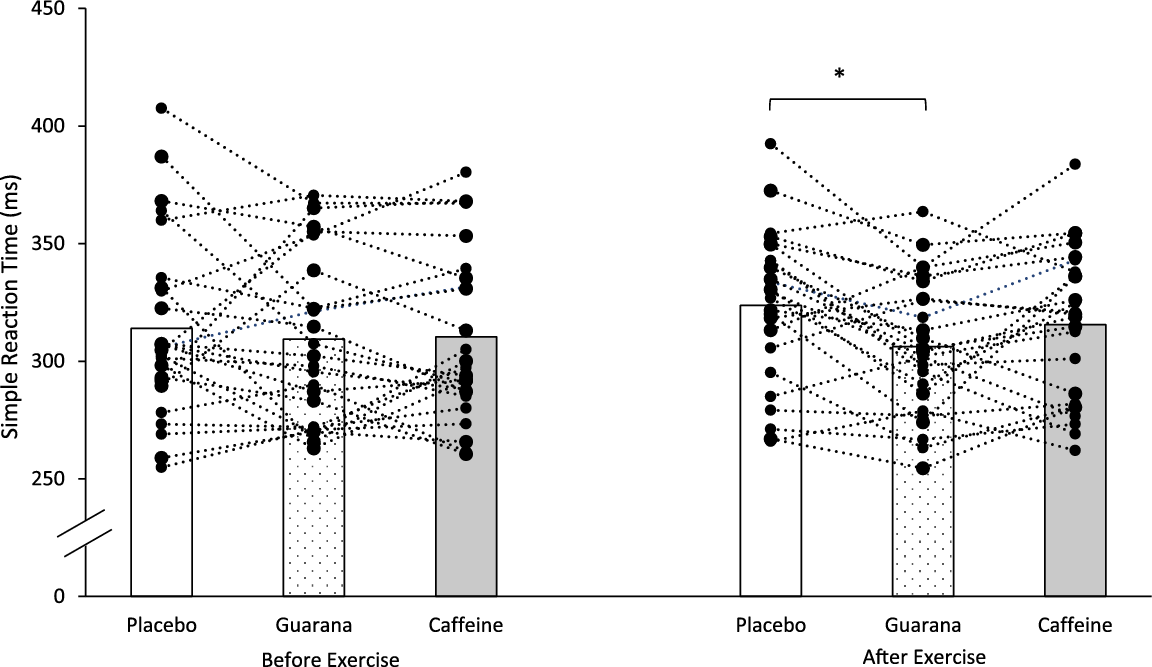
Fig. 1. Mean and individual simple reaction time (SRT) before and after exercise. *Signifies a significant difference (P ≤ 0·05) between supplements and SRT.
Therefore, guarana supplementation significantly reduced SRT after exercise compared with placebo, but not compared with caffeine.
Choice reaction time
A significant main effect was detected for CRT between supplements (P = 0·05, ES = 0·11, observed power = 0·57). There was no time effect or supplement × time interaction (P > 0·05).
Post hoc tests revealed CRT to be significantly lower before exercise following guarana supplementation (407 (sd 45) ms) in comparison with placebo (421 (sd 46) ms) (P = 0·030). No differences were reported between caffeine (417 (sd 42) ms) v. placebo or caffeine v. guarana before exercise (P > 0·05) (Fig. 2). Guarana had the same effect v. placebo when only the correct responses were selected (P = 0·018).
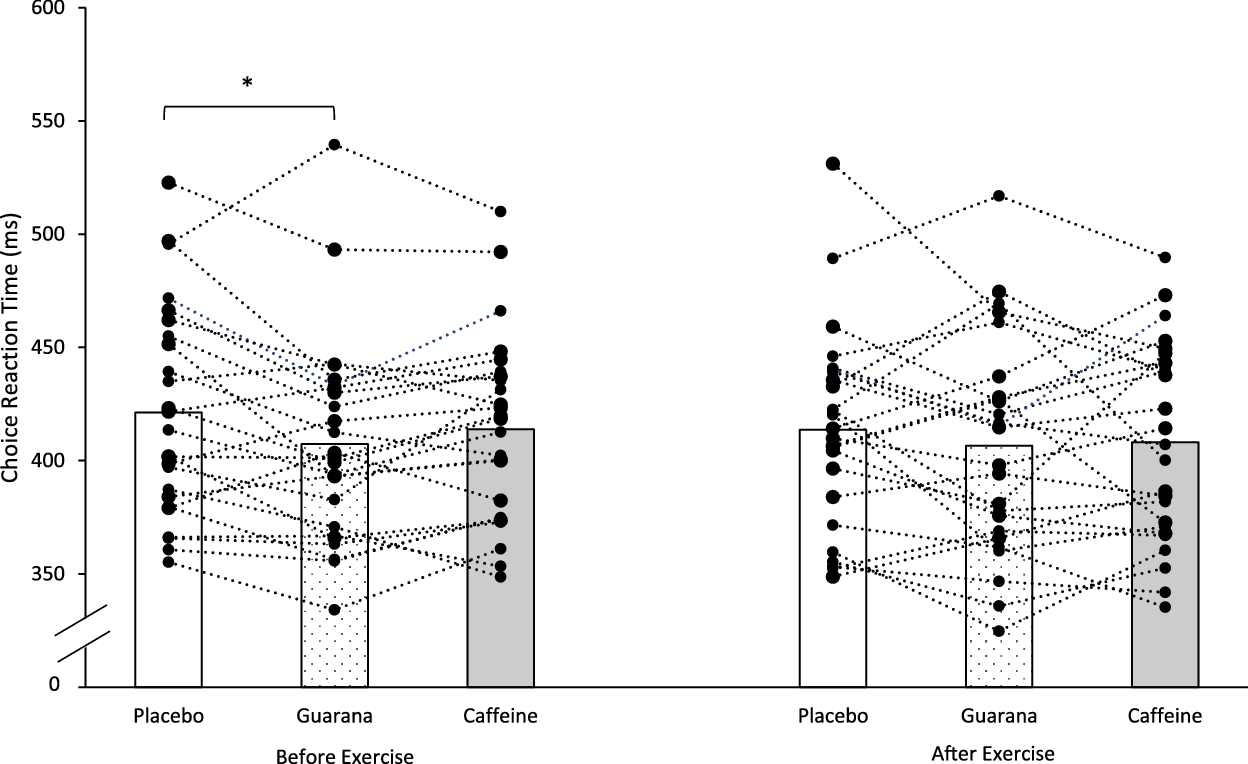
Fig. 2. Mean and individual choice reaction time (CRT) before and after exercise. *Signifies a significant difference (P ≤ 0·05) between supplements and CRT.
After exercise (including when only the correct responses were selected), post hoc tests revealed no differences between supplements (P > 0·05).
There were no differences in response accuracy percentage between placebo, guarana and caffeine (P > 0·05).
Therefore, guarana supplementation significantly reduced CRT response time compared with placebo following 30 min of rest, but there were no differences between supplements after exercise.
Intra-individual variability – inconsistency
For SRT and CRT IIV-I, there was no significant main effect between supplements or supplement × time interaction (P > 0·05).
A significant time effect was detected in SRT (P = 0·05, ES = 0·15, observed power = 0·50) where post hoc analysis demonstrated a significant increase in IIV-I from pre- to post-exercise for placebo (P = 0·007), whereas for guarana and caffeine there were no differences (P > 0·05).
A significant time effect was also detected in CRT (P = 0·007, ES = 0·26, observed power = 0·89) where post hoc analysis demonstrated guarana supplementation to significantly decrease IIV-I from pre- to post-exercise (P = 0·038). No differences were detected in placebo and caffeine, see Table 1.
Table 1. Intraindividual variability inconsistency for both choice (CRT) and simple reaction time (SRT) cognitive tests
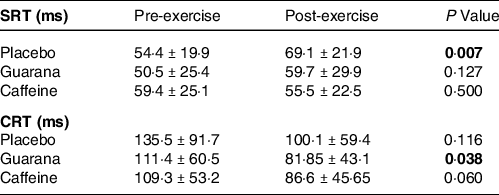
Bold indicates P < 0.05.
Therefore, SRT IIV-I increased significantly after exercise with placebo but not under supplementation with caffeine or guarana, and CRT IIV-I decreased significantly after exercise with guarana only.
Memory recall
There was no significant main effect, time effect or supplement × time interaction (P > 0·05) for memory recall between supplements.
Bond–Lader mood scales
Parametric assumptions were not met for alert scores; therefore, Friedman’s was employed. Friedman’s reported a significant increase in alert scores following guarana supplementation (63·3 (sd 13·8)) when compared with placebo (57·4 (sd 13·4)) following exercise only (P = 0·014). Kendall’s W reported 0·097, indicating a small ES. No differences were reported between caffeine (61·2 (sd 12·8)) v. placebo and caffeine v. guarana (P > 0·05).
There was no significant main effect, time effect or supplement × time interaction (P > 0·05) for all other Bond–Lader mood scale variables (content and calm) between supplements.
Physical performance
No differences in V̇O2max were detected between placebo (52·2 (sd 10·7) ml/min per kg), guarana (51·4 (sd 10·0) ml/min per kg) and caffeine (51·7 (sd 9·0) ml/min per g). Equally, no differences in peak power output were detected between placebo (300 (sd 80) Watts), guarana (299 (sd 81) Watts) and caffeine (305 (sd 81) Watts).
Daily caffeine intake
There was no correlation found between daily caffeine intake and performance on any task or supplement before or after physical activity, with the Pearson correlation coefficient less than 0·08 for all outcome measures.
Correlations
Spearman’s ρ was employed to investigate possible correlations between changes in alert scores and changes in SRT post-exercise (a) and changes in alert scores and changes in CRT IIV-I post-exercise (b). Despite a small trend for (a), the threshold was not met (P = 0·058). Similarly, there was no correlation identified for (b) (P > 0·05).
Discussion
The key novel findings of this study demonstrate that guarana supplementation decreased both SRT (after exercise) and CRT (before exercise) in comparison with placebo, supporting previous literature that guarana increases speed of attention(Reference Pomportes, Brisswalter and Casini6–Reference Pomportes, Davranche and Brisswalter8,Reference Kennedy, Haskell and Wesnes11,Reference Kennedy, Haskell and Robertson12,Reference Pomportes, Brisswalter and Hays16) . The supplementation of guarana also improved CRT IIV-I and alert scores, both after exercise. The protective effect against cognitive fatigue was further demonstrated by guarana, whereby SRT IIV-I was maintained following exercise while with placebo it was significantly higher.
The improvement in SRT following guarana supplementation is consistent with previous research and further supports the notion that guarana may possess cognitive stimulant-like effects which therefore enhances information processing speed(Reference Haskell, Kennedy and Wesnes7,Reference Pomportes, Davranche and Brisswalter8,Reference Kennedy, Haskell and Wesnes11,Reference Kennedy, Haskell and Robertson12) . These findings are also in line with previous investigations that sought to examine the possibility of guarana influencing cognition during/after physical activity whereby significant decreases in mean reaction time and improvements in temporal performance were reported(Reference Pomportes, Brisswalter and Casini6,Reference Pomportes, Brisswalter and Hays16) . IIV-I in the placebo group was significantly higher for SRT following exercise, whereas guarana and caffeine exhibited a plateau with no difference. These results allude to the fact that guarana supplementation can not only improve reaction time but may also do so without hindering cognitive consistency, as measured by trial-to-trial variability which could be caused by physical fatigue. In addition to this, although CRT did not improve after exercise, the IIV-I for CRT following guarana supplementation was significantly reduced (see Table 1), perhaps demonstrating that while participants did not improve in their CRT, they became more consistent with their response times after exercise(Reference Costa, Dogan and Schulz20). A mean improvement in consistency after exercise was observed in all conditions but was only significant with guarana supplementation, further suggesting that guarana supplementation in combination with exercise may improve cognitive performance. It is therefore possible that exercise may promote an increase in focus and alertness, which is further augmented by supplementing with a stimulant.
It is important to note that true comparisons to previous literature are difficult as key differences exist in exercise intensity and duration, as well as when cognitive tests commenced. For example, during the Pomportes et al. (2017) study, participants were exercising submaximally at 60 % peak power output for 40 min and completed cognitive tasks on the cycle ergometer during this time frame. Guarana supplementation led to an improvement in temporal performance (production) but did not positively influence cognitive control. It is likely that participants would have been in a heightened state of arousal throughout the testing, beyond what is optimal for cognitive performance(Reference Lambourne and Tomporowski23), whereas in this study and previous research, testing was completed after 5 min of recovery or immediately after physical activity(Reference Pomportes, Brisswalter and Hays16). Considering participants cooled down for 5 min before being taken to a quiet room for cognitive testing in the current study, this may have allowed for a sufficient amount of recovery before testing. It is also plausible that contrasting results in previous studies are due to differing administration methods. Some studies have combined the consumption of guarana with multivitamin complexes(Reference Pomportes, Brisswalter and Casini6) as well as just mouth rinsing(Reference Pomportes, Brisswalter and Hays16), while others have employed contrasting caffeine content in comparison with this study(Reference Haskell, Kennedy and Wesnes7,Reference Pomportes, Davranche and Brisswalter8,Reference Kennedy, Haskell and Robertson12,Reference Veasey, Haskell-Ramsay and Kennedy13) . In those studies, it is possible that other constituents contained in the multivitamin complexes may have interacted with the effects of guarana.
In the current study, guarana elicited a greater magnitude of effects than the equivalent caffeine dose of 5 mg/kg, suggesting that the combination of caffeine and guarana provides superior simulant-like effects. Despite this, the pharmacokinetics and central nervous system stimulant contributions of caffeine in the current study cannot be ignored. It is well known that caffeine supplementation results in heightened alertness, vigilance, attention and reaction time(Reference McLellan, Caldwell and Lieberman3). The rapid absorption of caffeine is mediated by the antagonism of adenosine receptors and the inhibition of phosphodiesterase(Reference Schimpl, da Silva and de Carvalho Gonçalves1). By competing with and blocking A1 and A2 adenosine receptors, indirectly, the release of norepinephrine, dopamine, acetylcholine and serotonin occurs (Kennedy(Reference Kennedy24)). The release of such neurotransmitters results in excitatory effects which are believed to alter cognitive performance in both habitual and non-habitual consumers(Reference Kennedy24). This is in keeping with an earlier study by Haskell et al. which demonstrated that both habitual consumers and non-consumers had a positive cognitive response from caffeine supplementation at both 75 and 150 mg doses(Reference Haskell, Kennedy and Wesnes25). However, daily caffeine intake did not appear to affect performance for any outcome measure in the current study. Guarana’s stimulant-like properties have historically been accredited to the caffeine content of guarana’s seed, but the results from this study add to growing evidence that caffeine cannot be acting exclusively(Reference Schimpl, da Silva and de Carvalho Gonçalves1,Reference Haskell, Kennedy and Wesnes7) . Haskell et al. (Reference Haskell, Kennedy and Wesnes7) observed guarana to be pharmacologically active at caffeine doses as low as 4·5 mg, below the threshold for activity in humans.
The interaction caffeine has with the other components found within guarana are not yet clear. Evidence suggests that synergistic relationships when co-consumed with other bioactive compounds may result in greater stimulant-like effects. For example, guarana contains traces of several other purine alkaloids (methylxanthines), such as theobromine and theophylline(Reference Kennedy24). Theobromine, a caffeine derivative, has a higher affinity for A1 receptors in comparison with caffeine, yet it has a longer half-life(Reference Mitchell, Slettenaar and Vd Meer26). Studies into these compounds do not suggest a consistent cognitive effect when administered alone but have shown that theobromine appears to act synergistically with caffeine(Reference Smit, Gaffan and Rogers27). As evidenced by Smit and colleagues(Reference Smit, Gaffan and Rogers27) whereby caffeine (19 mg) and theobromine (250 mg) combined capsules improved SRT tests, consistent with our current findings. There are also high levels of polyphenols such as tannins (total tannin concentrations estimated between 5 and 14 %) and saponins(Reference Marques, Ferreira and de Paula2,Reference Kennedy24) . Saponins derived from lychee seeds(Reference Wang, Wu and Yu28) and ginseng tea leaves(Reference Huang, Ding and Li29) have previously demonstrated to possess neuroprotective activities in vitro and in vivo. The interaction and target of HRAS (HRas proto-oncogene, GTPase), mitogen-activated protein kinase 1) and mitogen-activated protein kinase 8) in the blood–brain barrier via the advanced glycation end products – receptor for advanced glycation end products and PI3K-Akt (phosphatidylinositol 3-kinase – protein kinase B) signalling pathway are the purported mechanisms of action(Reference Huang, Ding and Li29). When co-consumed, saponins and tannins may also interact with caffeine and increase the bioavailability of phenols(Reference Kennedy24). Indeed, there is some promising data to suggest that phenols may improve some cognitive brain functions(Reference Ammar, Trabelsi and Müller30), though the data are not particularly consistent. Although the ingestion of guarana may exert similar stimulant-like effects to caffeine, the presence of tannins and saponins found in guarana may prolong this effect(Reference Babu, Church and Lewander31). It is therefore plausible to assume that the additional bioactive components of guarana may be acting concomitantly, investigating the psychoactive contribution of each requires more research in order to understand guarana’s full mechanism of action.
The study acknowledges several key limitations. First, the 5-min period between exercise and cognitive tests may not necessarily be translatable and applicable in the field, where athletes or professionals (police/military) are required to make crucial decisions while under physical exertion. Further research should therefore try to eliminate or reduce the time between exertion and testing. Applying relevant cognitive tests to real-world sporting or professional situations would also be pertinent, such tests could place further emphasis on problem solving and higher executive functioning rather than only SRT and CRT. Second, the sample size in the current study was small; therefore, caution must be taken when interpreting the results, particularly when considering the wider applicability of the outcomes. The authors also acknowledge that the study population was specifically young active individuals, some of which came from a cycling club; this therefore impacts the generalisability of the results. It is also plausible to suggest that variations in the erogenicity of caffeine supplementation, and by extension guarana supplementation, may be as a result of inter-individual subtle differences in CYP1A2 and ADORA2A genes(Reference Southward, Rutherfurd-Markwick and Badenhorst32), measurement of which was beyond the scope of the current study. However, recently there has been increasing conflicting evidence to indicate that caffeine supplementation provides a positive ergogenic response irrespective of the aforementioned genes(Reference Grgic, Pickering and Bishop33,Reference Glaister, Chopra and Pereira de Sena34) . Finally, although supplements were blinded, exit questionnaires were not employed to distinguish whether the participants knew or could guess which supplement they were on. Consequently, this may have influenced the result. Guarana has a distinct taste, but it is unlikely participants would have taken any on its own before and therefore be able to identify it. To combat this, future research could therefore investigate guarana using capsule form.
Practical and wider applications
This study provides promising evidence that guarana supplementation may be useful by sustaining, or possibly improving, decision making following maximal exertion. This may be particularly pertinent to activities that require bursts of high intensity exercise accompanied by rapid decision making, including team sports, law enforcement and military applications. Previous studies in law enforcement have in fact reported negative effects of stress and exertion on cognitive performance after physically demanding operational tasks(Reference Hope, Lewinski and Dixon35). Further research could explore the applicability of supplementation strategies in these more specific settings. The magnitude of effect observed with guarana appears to be higher than an equivalent dose of pure caffeine only. Future research should consider the effect of high intensity activity and cognitive performance simultaneously, in conjunction with guarana supplementation, and should consider these effects on higher executive functions that may be applicable to broader fields.
Conclusion
The findings of this study indicate that acute guarana supplementation leads to significant improvements in both CRT and SRT before and after a maximal bout of exercise, respectively, which is consistent with a heightened feeling of alertness. This improvement, with respect to placebo, is evident in guarana alone, despite a matched dose of caffeine content in the caffeine supplement. These effects appear promising for the use of guarana in sports which require fast response times to be maintained through high intensity physical activity.
Acknowledgements
The authors wish to thank all those who volunteered to participate in this study. The authors would also like to thank Matthew Spoor for conducting the exercise tests, Alireza Mani for conducting the HPLC testing and Ratdesh Perindanathan for his input on the written text.
The authors did not receive any funding for this research.
T. G. contributed to the statistical and data analysis, writing and drafting of manuscript and formation of figures. N. B. and D. I. collected data and helped with the drafting of the manuscript. F. R. supervised the study, contributed to the conception, design, drafting of manuscript and data analysis. All authors approved the final version of the manuscript.
The authors declare that there is no conflict of interest.





